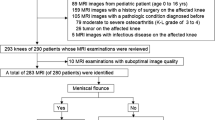Abstract
Purpose
The aim of this prospective study was to compare the accuracy of clinical examination and magnetic resonance imaging (MRI) versus arthroscopic findings and to determine the value of an experienced examiner in clinical decision making.
Methods
A total of 30 patients with a preoperative MRI underwent arthroscopy over a 5-month period. All patients had a clinical examination performed by an experienced knee surgeon, a specialist in general orthopedics, a senior resident, and a fourth-year resident. These examiners recorded and evaluated the results of seven tests: the medial and lateral joint line tenderness test, the McMurray test, the Apley test, the Stienmann I test, the Payr’s test, Childress’ sign, and the Ege’s test. The injury was classified as a meniscal tear if there were two positive tests.
Clinical history, physical examination, and MRI findings were compared with the arthroscopic findings. The accuracy, sensitivity, specificity, positive predictive value (PPV), and negative predictive value (NPV) of these methods of evaluation were then calculated.
Results
Clinical examination performed by an experienced knee surgeon had better specificity (90% vs. 60%), positive predictive value (95% vs. 83%), negative predictive value (90% vs. 86%), and diagnostic accuracy (93% vs. 83%) than MRI for medial meniscal tears. These parameters showed only a marginal difference in lateral meniscal tears. The experienced knee surgeon had better sensitivity, specificity, predictive values, and diagnostic accuracy parameters for medial meniscus tears in comparison with the other three examiners.
Conclusion
These results indicate that clinical examination by an experienced examiner using multiple meniscus tests is sufficient for a diagnosis of a meniscal tear.
Level of evidence
II.



Similar content being viewed by others
References
Akseki D, Ozcan O, Boya H, Pinar H (2004) A new weight-bearing meniscal test and a comparison with McMurray’s test and joint line tenderness. Arthroscopy 20(9):951–958
Alioto RJ, Browne JE, Barnthouse CD, Scott AR (1999) The influence of MRI on treatment decisions regarding knee injuries. Am J Knee Surg 12(2):91–97
Boden SD, Labropoulos PA, Vailas JC (1990) MR scanning of the acutely injured knee: sensitive, but is it cost effective? Arthroscopy 6(4):306–310
Boeree NR, Ackroyd CE (1991) Assessment of the menisci and cruciate ligaments: an audit of clinical practice. Injury 22(4):291–294
Bohnsack M, Ruhmann O, Sander-Beuermann A, Wirth CJ (1999) Comparison of clinical examination with NMR spectroscopy in the diagnosis of meniscal lesions in daily practice. Z Orthop Ihre Grenzgeb 137(1):38–42
Bridgman S, Richards PJ, Walley G, MacKenzie G, Clement D, McCall I, Griffiths D, Maffulli N (2007) The effect of magnetic resonance imaging scans on knee arthroscopy: randomized controlled trial. Arthroscopy 23(11):1167–1173
Brooks S, Morgan M (2002) Accuracy of clinical diagnosis in knee arthroscopy. Ann R Coll Surg Engl 84(4):265–268
Chang CY, Wu HT, Huang TF, Ma HL, Hung SC (2004) Imaging evaluation of meniscal injury of the knee joint: a comparative MR imaging and arthroscopic study. Clin Imaging 28(5):372–376
Crotty JM, Mom JUK, Pope TL (1996) Magnetic resonance imaging of the musculoskeletal system part 4. Clin Orthop Relat Res 330:288–303
Eren OT (2003) The accuracy of joint line tenderness by physical examination in the diagnosis of meniscal tears. Arthroscopy 19(8):850–854
Feller JA, Webster KE (2001) Clinical value of magnetic resonance imaging of the knee. ANZ J Surg 71(9):534–537
Jerosch J, Riemer S (2004) How good are clinical investigative procedures for diagnosing meniscus lesions? Sportverletz Sportschaden 18(2):59–67
Lundberg M, Odensten M, Thuomas KA, Messner K (1996) The diagnostic validity of magnetic resonance imaging in acute knee injuries with hemarthrosis. A single-blinded evaluation in 69 patients using high-field MRI before arthroscopy. Int J Sports Med 17(3):218–222
Miller GK (1996) A prospective study comparing the accuracy of the clinical diagnosis of meniscus tear with magnetic resonance imaging and its effect on clinical outcome. Arthroscopy 12(4):406–413
Mohan BR, Gosal HS (2007) Reliability of clinical diagnosis in meniscal tears. Int Orthop 31(1):57–60
Munk B, Madsen F et al (1998) Clinical magnetic resonance imaging and arthroscopic findings in knees: a comparative prospective study of meniscus, anterior cruciate ligament and cartilage lesions. Arthroscopy 14(2):171–175
Rose NE, Gold SM (1996) A comparison of accuracy between clinical examination and magnetic resonance imaging in the diagnosis of meniscal and anterior cruciate ligament tears. Arthroscopy 12(4):398–405
Ruwe PA, Wright J, Randall RL, Lynch JK, Jokl P, McCarthy S (1992) Can MR imaging effectively replace diagnostic arthroscopy? Radiology 183(2):335–339
Tria AJ Jr (2001) Clinical examination of the knee. In: Insall JN, Scott WN (eds) Surgery of the knee, vol 1, 3rd edn. Churchill Livingstone, NY, pp 161–174
Wee LL (2008) A comparison of accuracy between clinical history, physical examination and magnetic resonance imaging and arthroscopy in the diagnosis of meniscal and anterior cruciate ligament tears. J Orthopaed 5(3):e8
Conflict of interest
The authors declare that they have no conflict of interest.
Author information
Authors and Affiliations
Corresponding author
Additional information
The study was approved by the ethical committee of Haseki Training and Research Hospital, and written informed consent was obtained from all patients.
Rights and permissions
About this article
Cite this article
Ercin, E., Kaya, I., Sungur, I. et al. History, clinical findings, magnetic resonance imaging, and arthroscopic correlation in meniscal lesions. Knee Surg Sports Traumatol Arthrosc 20, 851–856 (2012). https://doi.org/10.1007/s00167-011-1636-4
Received:
Accepted:
Published:
Issue Date:
DOI: https://doi.org/10.1007/s00167-011-1636-4



